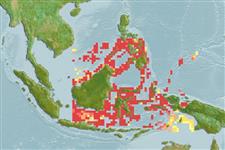Common names from other countries
Environment: milieu / climate zone / depth range / distribution range
Ekologi
. Tropical; 23°C - 30°C (Ref. 102835); 13°N - 9°S, 109°E - 139°E (Ref. 106696)
Western Central Pacific: Restricted in the tropical western Pacific. From Sabah, Malaysia to Palau, north to Philippines and south to Indonesia.
Length at first maturity / Size / Weight / umur
Maturity: Lm ? range ? - ? cm Max length : 41.1 cm SHL jantan/; (Ref. 117184); common length : 20.0 cm SHL jantan/; (Ref. 348)
Its shell is thinner and smoother than that of H. hippopus, usually devoid of pigmentation, and more semi-circular in profile. The mantle is similar to that of H. hippopus (Rosewater, 1982), except that prominent papillae line the margins of the incurrent siphon.
Collected for food and shell (Ref. 348). Found in shallow waters. Young specimens often byssally attached to coral heads, mature specimens lack a byssus and lay unattached on the substrate (Ref. 348).
Life cycle and mating behavior
Kematangan | Reproduksi, perkembang biakan | Pemijahan | telur-telur | Fecundity | Larva
Broadcast spawners. Life cycle: Embryos develop into free-swimming trocophore larvae, succeeded by the bivalve veliger, resembling a miniature clam (Ref. 833).
rujukan utama
Acuan | Koordinator | mitra
Poutiers, J.M. 1998. (Ref. 348)
Status IUCN Red List (Ref. 130435)
status CITES (Ref. 108899)
Not Evaluated
ancaman kepada manusia
Harmless
penggunaan manusia
Perikanan: komersial
FAO - Budidaya air: production; | FishSource | Sea Around Us
Alat, peralatan
Sumber internet
Estimates based on models
Daya lenting
Rendah, Waktu penggandaan populasi minimum 4.5 - 14 tahun (K=0.13).
keancaman
Low to moderate vulnerability (30 of 100).
kategori harga
Unknown.
